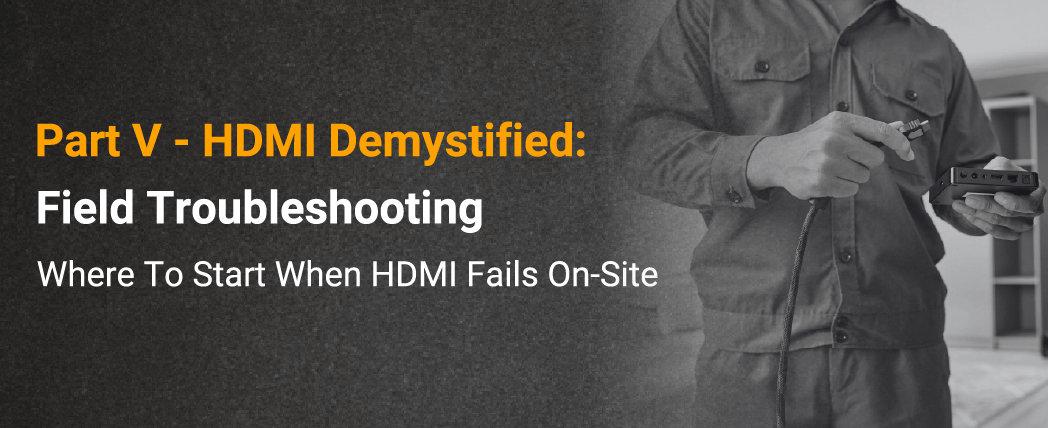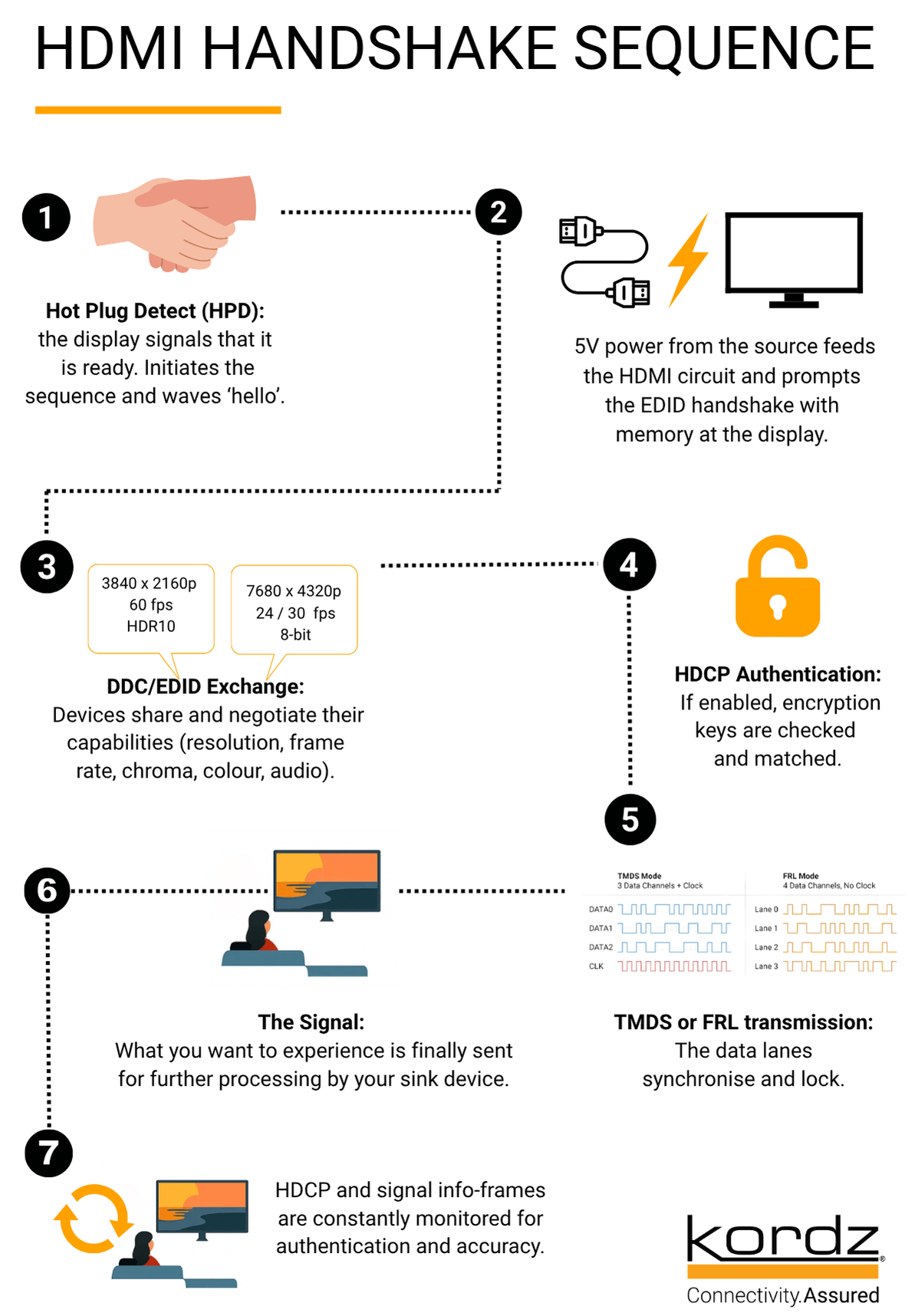
By James Chen, Managing Director, Kordz. With contributions from Ryan and Eric Wesley from The Front Row Podcast.
Introduction
It’s late in the day, your client is waiting, and their HDMI system still isn’t working. The display is blank, audio is dropping out, or switching between the sources is painfully slow. You’ve checked all the obvious things, but the fault isn’t going away.
Every integrator knows this scenario, and I’ve been there many times myself. HDMI is the backbone of modern residential AV, yet after two decades it remains one of the most common causes of site callbacks – and therefore profit erosion – on projects.
Why? Because HDMI was never designed to carry today’s huge bandwidths, dozens of audio channels or variable refresh rates. It was meant to be a simple point-to-point connector. What we ask of it today is far beyond its original brief.
In this article, the first of a series guiding you through field troubleshooting for HDMI, we want to help you save time on site and avoid callbacks with troubleshooting 101 – where to start when the signal isn’t working. These steps will solve most on-site failures quickly.
It’s a system, so don’t diagnose in insolation
Firstly, it’s important to remember that HDMI is part of a system and that’s the keyword – “system.” One of the most common mistakes we see integrators make is looking at HDMI runs in isolation. It’s easy to assume, for example, that a problem comes from a 20m projector cable when in reality, the signal has already travelled through a 3m patch, an AVR, a matrix, or an extender to get there. So, it’s best to think of HDMI as a signal carried through one continuous chain in which every device and patch plays its part -while also being a potential source of a problem. You cannot ignore that 3m lead because it may be the link that tips the system over the edge.
On-site tips:
- Remember, the more links in the chain, the greater the complexity and smaller your margin. Aim to design simple systems with quality products. Less is more.
- Always calculate the end-to-end path, not just the longest cable.
- Include every device: AVRs, splitters, scalers, reclockers, extenders.
The handshake dance and why sequence matters
HDMI doesn’t simply “switch on.” Every time a device is connected or reinitialised, it goes through a specific sequence of events we know as the “handshake.” This is the basic process:
That’s a lot of steps, and if any one of them fails, you’ll see it show up as a performance issue in your system.
Most of the time there’s no warning message, simply an incomplete, flashing, miscoloured or blank screen, or a slow response. The root of your issue is usually somewhere in the handshake.
On-site tips:
- Power the display on first, then the source.
- Reseat HDMI connections to trigger a clean hot plug.
- Allow the handshake to complete fully before pressing the remote again.
- If in doubt, a controlled power cycle can reset the sequence.
- That’s why reducing system complexity helps a lot!
How to decode symptoms
The fastest way to find the fault is by learning how to correctly identify and triage the symptoms. Here are some basic examples to get you started:
The system worked before but now it doesn’t
Stable systems often fail after seemingly unrelated upgrades. So, for example, new lighting or appliances may have added electrical noise to the shared circuit. Sometimes failure is also caused by lightning strikes and surges, or degraded electronics.
Blank screen, audio continues
Often an HDCP or EDID failure. Modern HDCP checks happen constantly in microsecond intervals. If the response is late, video can drop.
Intermittent audio dropouts
The link is running on the edge. As I noted in the podcast, audio usually fails first. Dropping the display resolution or frame rate can confirm this.
Slow switching between inputs
A handshake delay caused by too many devices in the chain or poorly made cables.
Heat and noise: Your silent saboteurs
Two things silently undermine HDMI performance: heat and electrical noise.
Heat
Ceiling voids can reach extreme temperatures. Heat alters electrical characteristics, reduces capacitance and accelerates breakdown in cables and electronics. In extreme heat, it’s common for electronics to overheat and shut down, and sometimes cables even melt.
Noise
Modern LED lighting, dimmers and appliances all inject noise directly into electrical circuits. This interference can affect HDMI operation when they share power and tip a marginal system into failure.
On-site tips:
- Keep HDMI runs and low powered cables away from noisy power lines.
- If a system fails when the lights are switched on but works when they’re off, suspect electrical noise.
- Consider rack ventilation and ceiling temperatures as part of your diagnosis.
Handle the cable properly
How you treat a cable matters as much as how it’s made.
On-site tips:
- Don’t fold HDMI cables over themselves.
- Maintain bend radius to avoid impedance bumps.
- Avoid running parallel to mains power or LED drivers.
Even small changes to geometry or shielding integrity can combine with other stress points and cause failure, as long cables can act like an antenna.

Quick isolation steps: Take it back to basics
When you’re on site and time is tight, these are the fastest ways to get going whilst you work on the problem:
- Simplify the path: connect source to display directly with a short, known-good cable.
- Use built-in tests: many devices now offer HDMI cable checks that simulate known loads.
- Hot-plug rest: reseat connections to restart the handshake.
- Quiet test: power down lights and noisy loads to see if stability returns.
Each of these helps identify whether the fault lies in the chain, the environment, or the cable itself.
Takeaway for integrators
HDMI failures are rarely random. They are the result of small margins being consumed by chain length, device count, heat or noise. By treating HDMI as a whole system, respecting the handshake sequence, and reading symptoms correctly, most failures can be resolved quickly on site.
If these first steps don’t work, then keep an eye out for the next instalment in this guide to HDMI troubleshooting. We’ll look at the more complex issues – like FRL versus TMDS behaviour, sparkles and pixelation, ARC and eARC return path issues, and when the cable itself is the cause.
HDMI may not have been designed for the demands we place on it today, but with a methodical approach you can keep systems stable and avoid those late night and weekend callbacks.
These are the same fundamentals we apply at Kordz when we design, engineer and test our products. Our goal is to equip integrators with connectivity that works reliably in the real world, not just in the lab.
Discover why Kordz is not your ordinary HDMI cable here.
This article is based on James Chen’s contribution to The Front Row podcast, to listen to the full episode, click here.
Frequently Asked Questions (FAQs)
Q: What’s the most common reason for HDMI failures in the field?
A: Choosing a poor quality cable. This still causes well over half the issues, as it represents more than 90% of the signal path in most systems. This is precisely why we created Kordz professional grade HDMI cables – to fix this problem for integrators.
Q: Why does my HDMI signal drop when the lights turn on?
A: LED lights and dimmers often inject electrical noise into shared circuits, affecting HDMI stability.
Q: How do I quickly test if the cable is the issue?
A: Replace the cable with a short, known-good HDMI cable directly from source to display.
Q: What does a blank screen but working audio mean?
A: Likely an HDCP authentication EDID failure — try reseating cables or power cycling.
Q: Can heat damage HDMI cables?
A: Yes, especially in ceiling voids or racks without ventilation. Heat can distort the cable’s electrical characteristics and sometimes even melts cables.
Keep Reading
Enjoyed the read?
Share This Article© 2025 Kordz International. All Rights Reserved.
Please note, re-publishing of the contents of this article is prohibited; however, Kordz encourages the link to this page to be shared. If media, distributors, educators or others wish to share this information, we request you author your own post or article and link it to this page on kordz.com.au








